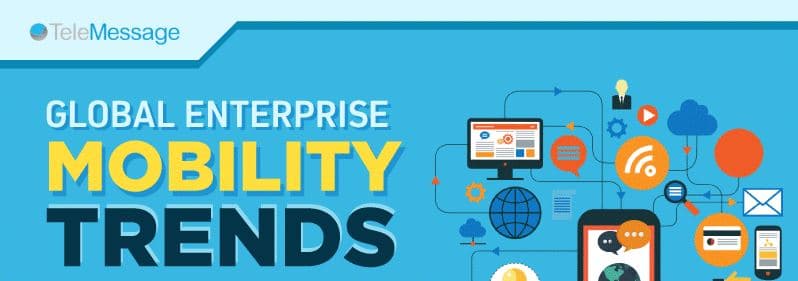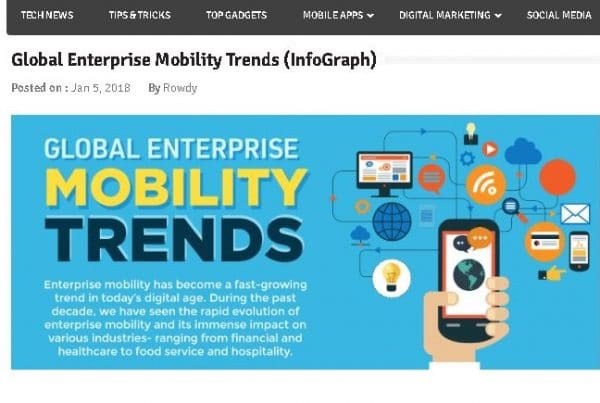Enterprise mobility has become a fast-growing trend in today’s digital age. During the past decade, we have seen the rapid evolution of enterprise mobility and its immense impact on various industries- ranging from financial and healthcare to food service and hospitality. With technology increasingly driving global market expansion mobility is a key priority to stay competitive.
According to statistics, 71% of enterprise across the world regard mobility as a top priority and the market is anticipated to reach a valuation of US$510.39 billion by the end of 2022.
While this concept isn’t all new, there are new changes that we haven’t seen before. Here are the latest shifts and trends in that are bound to shape the global enterprise mobility trends and landscape this year and beyond.

- More Enterprise-Tailored Apps
The use of mobile apps to improve operational efficiency and increase customer experience has recently accelerated
Companies are increasingly moving from generic apps to ‘enterprise-fit’ apps. Compared to ordinary consumer mobile apps, enterprise-tailored apps include specific functions unique to the organization. This avoids functional redundancy, and ensures user-specific features, resulting in a more streamlined workflow process
However, this demand faces increasing constraints. According to the Gartner research firm, by the end of 2017, market demand for mobile app development services will grow at least five times faster than internal IT organizations’ capacity to deliver them.
To overcome this app development challenges, Gartner encourages companies to formulate a process of mobile app prioritization that involves understanding the needs of business stakeholders.
- Increased Adoption of BYOD Policy
The Bring-Your-Own-Device (BYOD) policy is a growing trend, from $67.21 Billion in 2011 to about $181.39 Billion by the end of 2017.
However, companies must first overcome two fundamental issues associated with BYOD to ensure its successful implementation. First, most – if not all – employees’ devices are rarely equipped with enterprise-grade security features. Second, many in-house IT team are struggling to manage a wide range of BYOD devices across the organization.
To overcome these issues, implementing a Mobile Device Management (MDM) solution to help monitor, manage and secure employees’ mobile devices is widely advised.
- Increased Adoption of Hybrid Cloud Technology
Thanks to vast improvements in the cloud technology, more companies are now able to leverage its inherent potential, with hybrid cloud being the most preferred enterprise strategy.
At present, some 85% of enterprises have a multi-cloud strategy, up from 82% in 2016. In contrast, private cloud adoption fell from 77% to 72% in 2017.
Hybrid cloud is a cloud computing environment wherein the client hosts critical enterprise applications on-premise while also hosting other enterprise solutions in the cloud, giving businesses greater flexibility and more data deployment options.
- The Need for Cross-Platform Apps Will Increase
The increased adoption of BYOD also motivated the rise of multi-platform apps. Cross-platform applications are business solutions that can run on various devices rather than on a single platform.
With the variety of mobile devices in the workplace, developing mobile apps which can run on various mobile operating systems ensures a more effective BYOD implementation.
- Artificial Intelligence
Many companies across different industries are planning to harness the power of Artificial Intelligence (AI) to improve their products, services, and business process.
In the 2017 Economist Intelligence Unit report, 75% of more than 200 business executives surveyed said AI will be actively implemented in their companies within the next three years.
The same report also revealed the different motives of respondents for using AI:
- 27% say introducing artificial intelligence to business will improve decision making.
- 26% believe it will improve customer service.
- 29% say it will improve operating efficiency.
- 17% said it will increase sales revenue.
In a separate report from Narrative Science, it is noted that 80% of executives believe that artificial intelligence improves worker performance and generates more jobs.
That said, we can expect that more and more enterprise will utilize AIs to help them create smarter decisions and improve their overall competitiveness in the market.
- Multi-Layered Security Model
The proliferation of mobile device and apps in the workplace has only accelerated the importance of multi-layered security. According to National Institute of Standards and Technology, multi-level security is a class of systems containing information with different sensitivities that simultaneously permits access by users with different security without risk of compromise.
A layered security approach is a highly effective way to secure your BYOD environment. It helps IT meet the critical goal of protecting enterprise data without impacting user productivity or the native device experience.
Source:
https://globenewswire.com/news-release/2016/09/27/874868/0/en/Enterprise-Mobility-Market-is-forecast-to-grow-at-a-CAGR-of-24-7-by-2022-Global-Industry-Analysis-Size-Share-Growth-Trends-and-Forecast-2022-TMR.html
https://www.narrativescience.com/state-of-ai
http://www.marketsandmarkets.com/PressReleases/byod.asp
http://www.gartner.com/newsroom/id/3076817
https://www.rightscale.com/blog/cloud-industry-insights/cloud-computing-trends-2017-state-cloud-survey
http://searchcloudcomputing.techtarget.com/definition/hybrid-cloud
https://www.eiuperspectives.economist.com/technology-innovation/artificial-intelligence-real-world-0
http://csrc.nist.gov/nissc/1998/proceedings/panelF3.pdf





